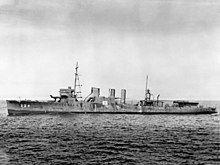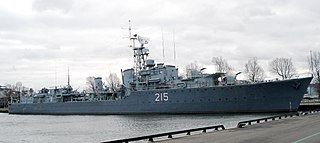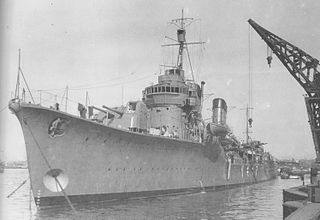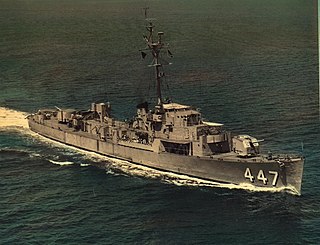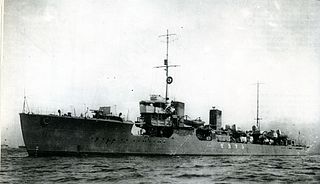Between the wars
On commissioning, Stewart was assigned to Destroyer Division (DesDiv) 37, a reserve division of Destroyer Squadron (DesRon) 3 of the Atlantic Fleet, transferring to DesDiv 39 in October that year. After a year of coastal operations for reserve squadrons, Stewart joined Destroyer Squadron, Atlantic, on 12 October 1921. [12] On 5 January, Stewart and five more destroyers left Charleston, South Carolina bound for the Caribbean, and on 6 January, Stewart was in a collision with Hopkins, sustaining minor damage. Stewart took part in fleet exercises in the Caribbean from 12 January to 23 February 1922 before departing for Philadelphia. After a period of repairs, during which she was fitted with an echo sounder, Stewart, together with the destroyer tender Black Hawk and the other 12 destroyers of DesRon 15, departed Newport, Rhode Island, on 20 June and proceeded, via the Mediterranean Sea and the Indian Ocean, to the Philippines for service in the Asiatic Fleet. She would not return to the US for 23 years. [12]
Stewart arrived at the Asiatic Fleet's base at Chefoo (now known as Yantai), China, on 26 August, and entered the routine of the Asiatic Fleet, which tended to operate in Chinese waters conducting training exercises from bases at Chefoo and Tsingtao in the summer and in Philippine waters, based at Cavite in the winter and making calls at Chinese ports during the transit in each direction. [12] On 2 September 1923, Stewart left Dalian, China, arriving at Yokosuka, Japan, on 5 September to carry out relief operations (along with most of the destroyers of the Asiatic Fleet) in response to the Great Kantō earthquake which had heavily damaged that city and Tokyo on 30 and 31 August. [12] Stewart left Chinese waters on 25 October 1923, arriving in the Philippines on 28 October, when she was docked down at Olongapo, with repair work continuing at Cavite until 18 November.
In early 1924, Stewart carried out surveying operations using her echo sounder. From 25 May to 16 June 1924, Stewart supported the flight of four US Army Douglas World Cruiser aircraft around the world, operating first in Japan and then at Shanghai. [12]
Between 1924 and 1928, there were outbreaks of anti-foreign disturbances at Shanghai and Canton. Stewart transported marines to Shanghai in January 1925, and during the next years, spent periods augmenting the normal gunboat patrols on the Yangtze River and on the coast near Canton. [12] Further outbreaks of unrest on cites on the Yangtze in September 1926, associated with the Northern Expedition of the Kuomintang led to Stewart being ordered upriver, and on 5 September, she was on passage between Shanghai and Hankou with the destroyer Pope when the two destroyers were fire on from the shore, with two men aboard Stewart slightly wounded. The two American destroyers did not return fire on this occasion. It was reported that all foreign steamers entering or leaving Hankou were being fired on by Kuomintang forces. [22] On 10 September, Stewart and the gunboat Palos and the minesweeper Pigeon when they came under rifle and artillery fire. This time, Stewart returned fire with rifles, machine guns and one 4-inch shell, which stopped the fire from shore. [23]
On 18 February 1927, Stewart and the destroyer Paul Jones left Manila to search for the Elkton, a US merchant ship that had gone missing after leaving Iloilo on 9 February bound for New York with a cargo of sugar and coconut oil. The search, which was joined by the destroyers William B. Preston and Sicard on 20 February, was abandoned on 24 February, with nothing being found. [24] Stewart was at Shanghai on 24 March 1927 when National Revolutionary Army troops attacked foreigners in the Nanking incident. [12] [25] For the next few months, the destroyer remained on the Yangtze, being based at Wuhu, Nanking, Shanghai, and Chenglin. [12] On 27 March Stewart was on the way to Wuhu, when she was fired on, wounding three crewmen.Stewart was in collision with the merchant ship SS Luen Ho while on passage down the Yangtze on 5 November 1927, with the destroyer suffering a dented side. She remained in Chinese waters until 14 January 1928.
Stewart was off coast of China, near the Matsu Islands, when the Japanese launched an air and sea attack on Shanghai, the January 28 incident in late January 1932. The destroyer was ordered to Swatow to protect American citizens, remaining there from 1 to 3 February, before proceeding to Amoy, where she remained from 9 to 24 February, before arriving at Shanghai on 26 February 1932. [12] On 23 March, Stewart collided with the British sloop HMS Sandwich and two Chinese barges. While Sandwich and one of the barges received little damage, the other barge lost a length of anchor chain, some of which ended up wound around Stewart's port propeller, which was badly damaged and required replacement.Stewart remained at Shanghai until 12 May 1932. [12]
In January 1934, Stewart started an overhaul and repair period at Cavite alongside the Black Hawk, with work including inspecting and repairing the ship's port turbines. A fire broke out aboard on 10 February 1934 which was quickly extinguished. [28] The overhaul continued into March, with Stewart demonstrating a speed of 32 kn (37 mph; 59 km/h) during post repair sea trials. On 14 July 1934, Stewart dragged her anchor while at Chefoo, colliding with the Chinese warship Chuyku, but only sustained minor damage.
After full-scale war between Japan and China broke out in 1937 Stewart was continued to spend much of her time at Chinese ports and was stationed at Tsingtao and Shanghai from 15 August to 17 October 1937. [12] On 1 October, Stewart was at Shanghai when Chinese aircraft carried out several air raids against Japanese ships and troops, with several bombs dropped near Stewart. After a mail run to Yokohama, Japan between 17 and 30 October, she returned to Chinese waters, leaving Shanghai on 18 December carrying newreel footage of the Japanese sinking of the American gunboat Panay.Stewart was again stationed at Chinese ports from 21 February to 21 March 1938. [12] On 30 July 1938, Stewart and the destroyers Pope and Parrott left Manila to search for the missing Pan American Airways flying boat Hawaii Clipper with the search continuing unsuccessfully until 6 August.Stewart returned to Chinese waters from 3 June to 4 September 1939. On the latter date, after the outbreak of war in Europe, she was ordered south for patrol duties in the Philippines, which she continued until entering the Cavite Navy Yard for overhaul on 5 April 1940. Upon leaving the yard on 1 June, Stewart acted as plane guard vessel for seaplanes flying between Guam and the Philippines and then made a final tour of Chinese Yellow Sea ports from 7 July to 23 September 1940. [12] During 1941, she remained in the Philippines as the international situation worsened, carrying out patrols in Manila Bay and the southern Philippines.
World War II
On 27 November 1941, [12] [lower-alpha 1] Admiral Thomas C. Hart, commander of the Asiatic Fleet, after receiving a war warning from the Chief of Naval Operations, ordered the major warships of the Asiatic Fleet to disperse to ports in the southern Philippines and the Dutch East Indies to minimise the potential for the fleet to be knocked out by Japanese air attack in the event of war, and to ease potential link up with Dutch forces. Stewart, along with the cruiser Marblehead and the destroyers Barker, Bulmer, Paul Jones and Parrott, was ordered to Tarakan in Borneo, arriving there on 29 November.Stewart was still at Tarakan when news of the outbreak of hostilities with Japan arrived on 8 December. [12]
During the final weeks of 1941, she escorted naval auxiliaries from the Philippines to Port Darwin, Australia. On 9 January 1942 Stewart was one of five destroyers in an escort composed of the cruisers Boise and Marblehead, with the other destroyers Bulmer, Pope, Parrott, and Barker departing from Darwin to Surabaya escorting the transport Bloemfontein. That transport had been part of the Pensacola Convoy and had left Brisbane 30 December 1941 with Army reinforcements composed of the 26th Field Artillery Brigade and Headquarters Battery, the 1st Battalion, 131st Field Artillery and supplies from that convoy destined for Java.
On 30 January, Stewart joined Marblehead and sortied with her from Bunda Roads on 4 February to intercept Japanese forces at the south entrance to the Macassar Strait. However, Marblehead was badly damaged by air attacks during the day, and Stewart escorted her back to the base at Tjilatjap, Java.
Stewart joined Admiral Karel Doorman's striking force under the American-British-Dutch-Australian Command on 14 February for an attack on Japanese forces advancing along the northern coast of Sumatra. During the approach, Stewart had to back her engines to avoid a Dutch destroyer ahead of her which had run aground on a reef in Stolze Strait, and, on the following day, 15 February, she survived numerous air attacks in the Bangka Strait. Although they damaged no Allied ships, the air attacks convinced Admiral Doorman that further advance without air cover would be foolhardy, and the Allied force retired. Stewart was detached on 16 February to fuel at Ratai Bay in Sumatra.
Admiral Doorman's forces were scattered when the Japanese landed on Bali on 19 February, and he threw his ships against the enemy in three groups on the night of 19 and 20 February in the Battle of Badung Strait. Stewart was lead ship in the second group and, in several brief but furious night engagements, came under extremely accurate fire from Japanese destroyers. Her boats were shot away, her torpedo racks and galley were hit, and a crippling shot hit the destroyer aft below her water line, opening her seams and flooding the steering engine room. However, the steering engine continued to operate under 2 feet (610 mm) of water; and the destroyer was able to maintain her station in column and return to Surabaya the next morning.

